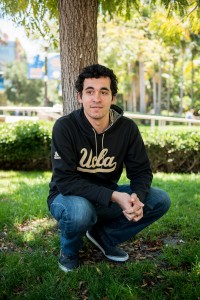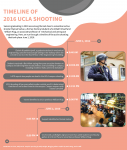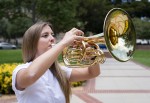Graduating seniors, what legacy are you leaving behind this year?
Many will say good memories and lifelong friendships. But as graduation season kicks off, confetti begins to line Janss Steps and orders of one-use caps, gowns and sashes begin to fly in, and it becomes clearer that the legacy left behind might not be so environmentally friendly.
We’ve come to see this as a tradition for the typical college graduate – graduation photoshoots with confetti and glitter become a must. What isn’t so obvious is the environmental harm that lies in these seemingly innocent pieces of plastic.
Confetti is classified as a microplastic, and because of its small size, it easily enters water pathways and oceans. These small-but-deadly bits of plastic contribute to the current 800 tons of plastic that flow into our oceans every year and have a lifespan of hundreds of years.
Associate professor Deepak Rajagopal of the UCLA Institute of the Environment and Sustainability said that confetti’s damaging presence on campus is due to its size.
“These small bits of colorful plastic … are a problem because they’re very hard to clean,” Rajagopal said. “No one’s going to collect it.”
A quick walk on Janss Steps or past Royce Hall makes it clear that these colorful specks of plastic have taken over Bruin territory.
First-year environmental science student, Director of Advocacy and Outreach for Team Green at UCLA and next year’s Director of Sustainability Jasleen Kahlon said that graduation-related litter all around UCLA’s campus has been sad to see.
“(Students) are hardly thinking of the effects of pollution and littering,” Kahlon said. “So many of our environmental issues that are (supposedly) difficult to tackle are a matter of convenience – this is just people being ignorant.”
Luckily, there are sustainable alternatives so UCLA students don’t have to sacrifice sparkle in their photos.
Companies such as Ecofetti have taken note of the environmental dangers of microplastics such as traditional confetti, and have since created a “water-soluble, non-toxic and biodegradable alternative.”
“People need to realize that there are eco-friendly ways to celebrate and take creative photos,” Kahlon said. “Making confetti out of leaves by hole-punching dry ones or scattering flower petals (are more sustainable options).”
UCLA students, for the most part, have become increasingly aware of what items they’re using while celebrating, said Justin Wisor, the Director of Custodial and Grounds at UCLA Facilities Management. He attributes this increasingly sustainability oriented sentiment as the source of general decrease in the presence of confetti during the graduation season.
But confetti is just one part of the problem. Graduation products such as caps, gowns and sashes leave behind a carbon footprint due to their unsustainable materials, as well as their one-use culture.
According to the The Robin Report, producing the amount of polyester fiber needed for one T-shirt emits twice as much carbon dioxide as for a cotton T-shirt.
Harmful materials aside, the one-use culture of caps, gowns and sashes also takes a toll on the environmental sustainability in graduation festivities. Approximately five million graduation gowns go to the landfill each year.
To remedy this, Kahlon suggests that UCLA implement a reuse program for caps and gowns, with a total or partial refund to students for returning their items.
“People often like to buy (their cap and gown) and keep it, but I’m not so sentimental about it,” Rajagopal said. “When I graduated from graduate school, I rented it for $75.”
Many big-name graduation companies such as Herff Jones and Jostens have taken the initiative in creating eco-friendly alternatives to the traditional cap and gown. Herff Jones now offers both a rental and keeper gown option, which are both made from 100% recycled materials. Jostens has also come out with the REsponsible REgalia™ line, whereby all keepsake gowns are 100% biodegradable.
Kahlon thinks that making a bigger deal about the issue will force students to give their actions more thought.
“It might be a really good idea for us to host a workshop on eco-decorating for celebratory events and grad photos,” Kahlon said. “There are tons of ways to get creative with this, from confetti and photo materials to decorating for parties to gift wrap.”
In order to counter this tendency for students to partake in graduation festivities without regard for the environment, a one-time fix such as an eco-friendly alternative to confetti may not be the long-term answer. Rajagopal said that it is instead necessary to view environmentalism as ethics to live by.
“Environmentalism has to be part of you, instead of a one-time thing. It’s something that we have to introduce through school to our kids at a young age, in college and in life after they graduate,” Rajagopal said. “That’s the culture we need.”







